What does it take to clear an Asian hornets' nest?
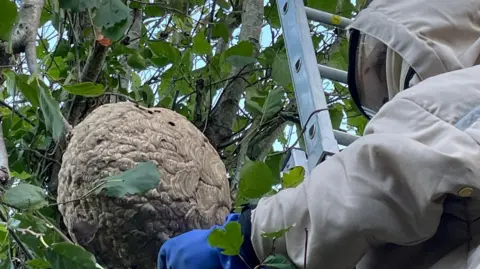 Asian Hornet Team
Asian Hornet TeamFinding and removing Asian hornet nests in the Channel Islands is a challenge which is only going to grow, according to experts.
Asian hornets have spread through Europe after arriving in southern France in a consignment of pottery in 2004.
The invasive species, first discovered in the Channel Islands in 2016, feeds on native bees and wasps, damaging biodiversity
Experts, such as Guernsey's Asian Hornet Team, are at the forefront of the battle to track and control the spread of the insects, but have warned it is a battle they may not win.
'Sting through the fabric'
Francis Russell, invasive non-native species policy and co-ordination officer, said the insects which "attack with vengeance" need to be approached with caution.
"A full body, purpose-made hornet suit is essential as hornets will sting through the fabric of a standard beekeeping suit," he said.
He said the suits, boots and goggles, special lances which release insecticide and cherry pickers to reach the nests were essential to removing them safely.
Gaining safe access to get within reach of a nest is the greatest challenge the team faces according to Mr Russell.
"This often means working at great heights often on sloping ground, in steep wooded valleys, on coastal cliffs or on the rock face of reservoirs," he said.
Mr Russell along with pest control technician Damian Harris have disposed of 36 secondary nests since 2019 without either of them being stung.
Despite the team's efforts, Mr Russell warned that as hornet populations in France continue to increase and without effective nationwide control, the "threat will continue".
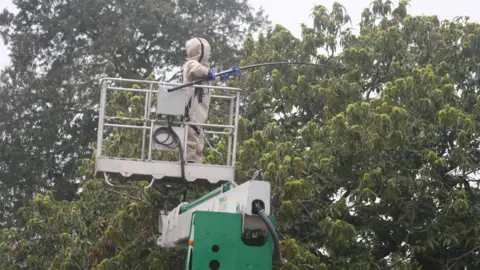 Asian Hornet Team
Asian Hornet TeamFinding nests involves tracking hornets.
"We put out bait stations, jars of sugary bait with a wick in the lid, This attracts them to feed and go to and from nests," said Mr Russell.
"Typically, nests are within 500 metres from where the insects feed which allows the hornet team to observe them flying away from the bait station.
"It takes a lot of skill and patience, but we visually track them down these flight lines – binoculars are essential.
"If high up in a building, cliff, or treetop, there is no immediate threat.
"If low down the nest needs to be cordoned off and public or landowners warned.
Mr Russell said: "Our plan of action often involves other operatives to gain access such as tree surgeons or cherry pickers.
"If the nest is in a built-up area, we do a letter drop 'advisory notice' to all residents within 100 metres informing them of the day and time of treatment."
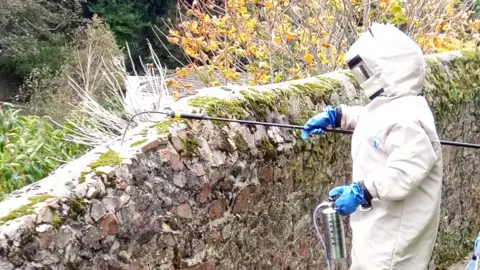 The Asian Hornet
The Asian Hornet"The smallest nests are the primary nests made by the queen during May to June, these are between golf ball-grapefruit size," said Mr Russell.
"These early nests are easy to remove without insecticides.
"By the end of October, a secondary nest can get extremely big such as the one removed from Sark in 2023 which was the biggest so found so far at 50 by 75 centimetres."
Two to three hours after being treated with pesticide the nest is safe to remove and can be cut smaller if needed.
Mr Russell said hornets will "attack with a vengeance and in large numbers", which is a natural response when a nest has been disturbed.
"Even before the nest is treated, guard hornets can detect changes in CO2 and visually detect animals approaching the nest.
"Vibrations of attached vegetation or branches is often enough to trigger an attack which is why gardeners and tree surgeons are at increased risk of being stung."
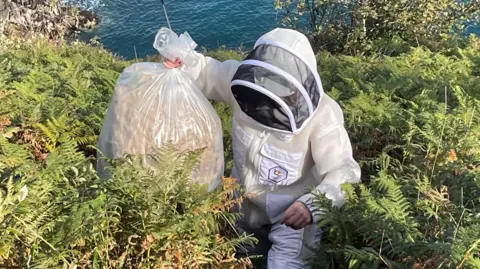 Asian Hornet Team
Asian Hornet TeamOnce removed the nests are double bagged, and zip tied to prevent contamination during transit.
All nests are placed in a chest freezer for a minimum of 48 hours to kill any unemerged hornets.
"Gaining safe access to get within reach of a nest is the biggest challenge," said Mr Russell.
"The other challenges are where we need to secure the area - keeping the public from entering a high-risk zone."
He said they work with the civil protection volunteers and Traffic and Highways department to close roads and keep the public safe.
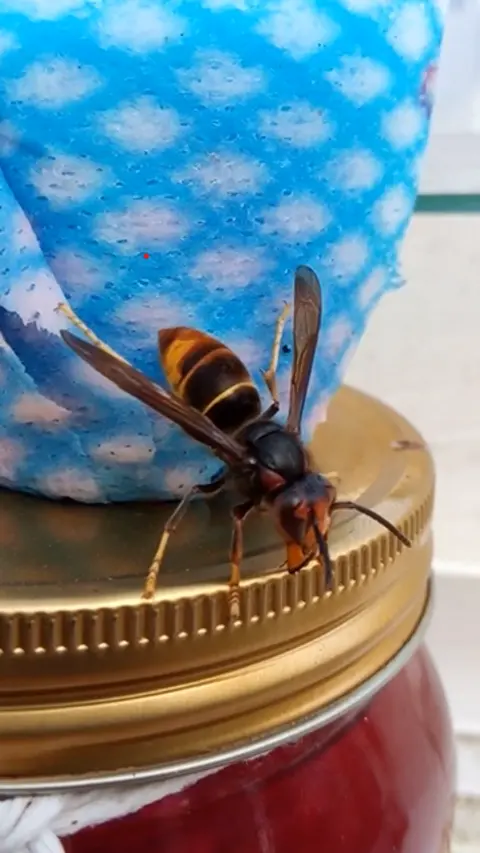 Asian Hornet Team
Asian Hornet Team"While the hornet populations in France continue to increase and in the absence of any effective nationwide control solutions where hornets have established, we will face a continuing threat on two fronts," said Mr Russell.
"Queens arriving from France unaided, flying to the Channel Islands every spring.
"We are fortunate in being the furthest island from the French coast.
"In future, we may also find that queens from Jersey will extend their range and hop to other islands.
"Secondly, hibernating queens can be transported long distances on boats, vehicles, and cargoes although this is not such as high risk as UK ports such as Dover, Folkstone and Hull."
Follow BBC Guernsey on X and Facebook. Send your story ideas to [email protected].
